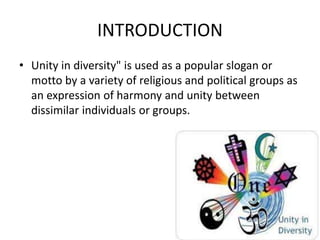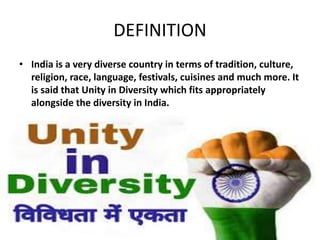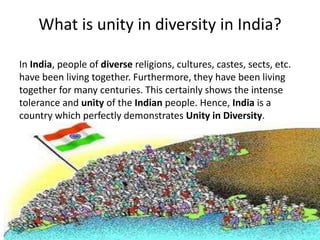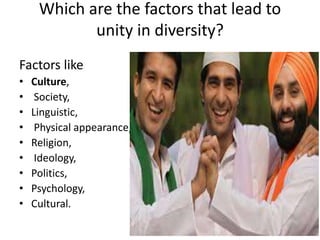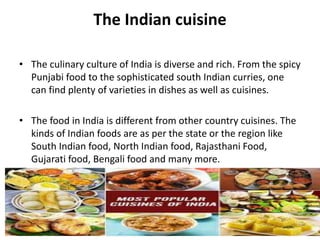Unity in Diversity
- 2. INTRODUCTION ? Unity in diversity" is used as a popular slogan or motto by a variety of religious and political groups as an expression of harmony and unity between dissimilar individuals or groups.
- 4. DEFINITION ? India is a very diverse country in terms of tradition, culture, religion, race, language, festivals, cuisines and much more. It is said that Unity in Diversity which fits appropriately alongside the diversity in India.
- 5. What is unity in diversity in India? In India, people of diverse religions, cultures, castes, sects, etc. have been living together. Furthermore, they have been living together for many centuries. This certainly shows the intense tolerance and unity of the Indian people. Hence, India is a country which perfectly demonstrates Unity in Diversity.
- 6. Who says unity in diversity? Jawaharlal Nehru, the first Prime Minister of India and leader of the Indian National Congress, vigorously promoted unity in diversity as an ideal essential to national consolidation and progress.
- 7. Which are the factors that lead to unity in diversity? Factors like ? Culture, ? Society, ? Linguistic, ? Physical appearance, ? Religion, ? Ideology, ? Politics, ? Psychology, ? Cultural.
- 8. What is diversity meaning? Diversity refers to the reality created by individuals and groups with the concept of acceptance and respect.
- 9. What are the main factors of diversity? Primary dimensions of diversity include ? Age, ? Ethnicity ? Culture, ? Gender, ? Race, ? Religion, ? Sexual orientation, and ? Capabilities (schwind, das, & wagar, 2007
- 10. What are the benefits of diversity? The benefits of diversity in the workplace ? New perspectives. When you hire people from diverse backgrounds, nationalities, and cultures, you're bringing a fresh array of perspectives to the table. ? Wider talent pool. ? More innovation. ? Better employee performance. ? Increased profits.
- 11. What are the negative effects of diversity? Cultural diversity can affect the workplace in numerous ways. Negative effects can include ? Miscommunication, ? Creation of barriers, and ? Dysfunctional adaptation behaviour's.
- 12. How many languages are spoken in India? ? As per the Constitution of India, Hindi is the official language. The Eight Schedule of the Indian constitution enlists 22 languages which are the scheduled languages. ? However, there are as many as 1652 languages or more than are spoken in various regions of India.
- 13. Festivals of India Festivals of India ? There are several festivals celebrated in India. Every religion, caste and culture has its festivals and occasions to celebrate. ? There are national festivals like Independence Day, Gandhi Jayanti and Republic day celebrated across India. ? The most celebrated festivals in India are Diwali, Holi, Dusshera, Durga Pooja, Eid, Guru Nanak Jayanti, Mahavira Jayanti, Christmas, and many more.
- 14. Art, literature and architecture in India ? India has very rich art, literature and architecture from ancient wonders to the modern marvels. They have flourished in India for centuries. ? One of the most popular and oldest known works of literature is the epic Ramayana.
- 15. Dance and music forms in India The classical dance forms of India include ? Bharatnatyam, ? Kathakali, ? Manipuri, ? Kathak, ? Odissi, ? Kuchipudi, ? Mohiniyattam and more.
- 16. ? The folk dances are performed on several occasions like festivals and celebrations. ? They include ? Bihu, ? Gaur, ? Chhau, ? Padayani, ? Dollu, ? Dumhal, ? Garba, ? Dandiya, ? Kunitha and many more. Dance and music forms in India
- 17. The Indian cuisine ? The culinary culture of India is diverse and rich. From the spicy Punjabi food to the sophisticated south Indian curries, one can find plenty of varieties in dishes as well as cuisines. ? The food in India is different from other country cuisines. The kinds of Indian foods are as per the state or the region like South Indian food, North Indian food, Rajasthani Food, Gujarati food, Bengali food and many more.
- 18. CONCLUSION Diversity and unity in diversity teach us that despite belonging from different religions, races, cultures, or anything else, the differences cannot keep people apart.

